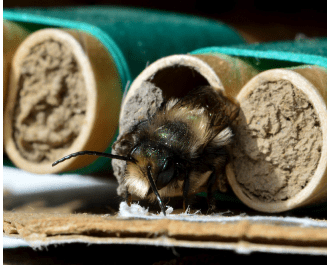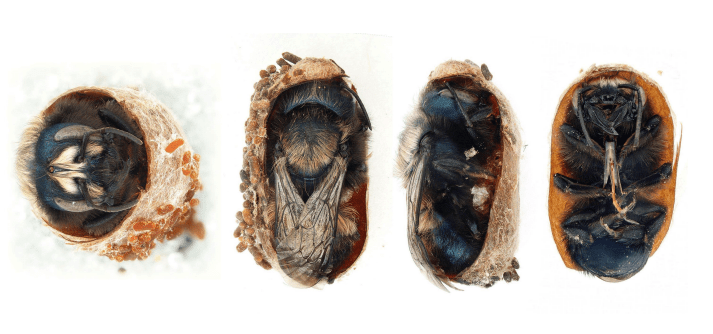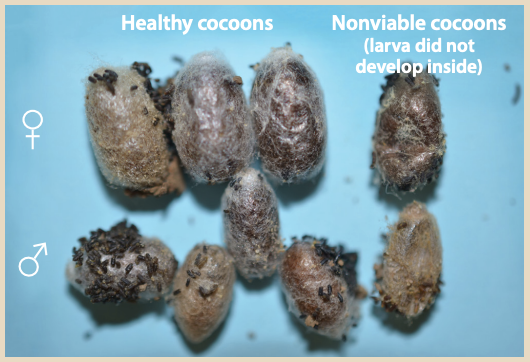Bees and other pollinating insects can greatly benefit when home gardeners provide a pollinator-friendly habitat. The native bee Osmia lignaria — commonly called the blue orchard bee or mason bee — is easy for western Oregon gardeners to nurture. Mason bees fill a unique niche in our area: They are active in early spring, before most other pollinators.
“Mason bee” is a general name for bees that build chambered nests in small crevices or holes using collected mud. Mason bees cannot create their own holes — they need pre-existing holes or crevices or nesting sites provided by a gardener.
Mason bees generally pollinate about 95% of the flowers they visit. Because they are relatively nonaggressive, they are easier to integrate into urban areas than honey bees. Mason bees are a fun hobby for the backyard gardener, beneficial pollinators for a variety of plants, and are especially prized for their efficiency in pollinating fruit trees. (Their economic value to Oregon is their effectiveness as pollinators of apples, cherries and pears.)
Basic biology
Mason bees (Figure 1) are different from honey bees, bumble bees, and wasps in their appearance and behavior. Both female and male mason bees are shiny, dark blue-green. Female mason bees are about the same size as honey bees. Males are slightly smaller, have light-colored hair on their face, and antennae one segment longer than the female.
Mason bees are solitary and do not live in colonies or hives like honey bees; however, they will build nests adjacent to each other (Figure 2). Mason bees do not produce honey. They sting only if they are handled roughly or are trapped under clothing. Mason bee adults have a short active period and in western Oregon are only seen from March to May or mid-June.
Life cycle
Mason bees have one generation per year. When the air temperature reaches 50°F to 55°F in early spring (February through March in western Oregon), the adult mason bees begin to chew their way out of their small (¼- to ⅝-inch or 0.7- to 1.5-cm) graybrown cocoons and through the mud walls of the chambers in their nesting holes. Males emerge first (Figure 3) and wait to mate with the females, which emerge 2 to 5 days later. Once fertilized (typically after 3 to 5 days), a female mason bee locates a suitable nesting site and then immediately begins foraging.
The female (Figure 4) visits flowers to collect nectar and pollen (pollinating the flowers while doing this) and brings the pollen and nectar into the nesting hole. She then forms the nectar and pollen into a rough-shaped ball and lays one egg on it. The female then collects mud and uses it to seal off the egg and nectar-pollen ball in a chamber.
The female mason bee repeats the process of collecting nectar and pollen, laying eggs, and walling off with mud until there are 5 to 8 egg chambers per nesting hole. She caps completed nests with mud at the end. Then she moves to a new nesting hole and continues this process until the season ends or she dies.
The female mason bee has control over the sex of each egg she lays. Females can lay haploid (unfertilized) eggs that become males and diploid (fertilized) eggs that become females. Eggs laid further than 3 inches from the entrance of the nesting hole are usually females, and eggs laid in the outer 3 inches of the hole are usually males. This is why it is important that the nesting holes a gardener provides be about 6 inches deep. Shorter holes result in a mostly male population. Typically, the ratio of male to female eggs is 2:1.
Within a few days to a week, a legless, creamcolored larva emerges from an egg. The larva feeds on the nectar-pollen ball. After about 10 days, the larva begins spinning a cocoon around itself. Inside the cocoon, the larva forms a pupa that in the fall transforms into a fully developed adult (Figure 5). The adult bee—still in the cocoon—enters a winter dormant state. The cycle begins again when temperatures rise in spring and the adults emerge from dormancy.
Getting started with mason bees
The following recommendations are the best practices for a high rate of success. Less intensive methods (for example, not cleaning cocoons or using cold storage) can still be successful, but survival rate may be lower.
What key items does my yard need for success with mason bees?
Moist clay soil
The female bee needs access to moist clay to build the chamber walls in the nesting hole. Soil or mud that is too sandy is not suitable because it will crumble. If your soil is not naturally high in clay, you can set out a container or small pile of mud that is high in clay. Wet one side of the pile to create mud that ranges in moisture from dry to very wet. The mason bees will choose the mud with the right moisture level.
If clay mud is not available, then mason bees will not use the nesting site you have provided.
Spring flowering plants close to nesting site
Adult mason bees are active from March through May or mid-June. Plant your garden so there are continuous blooms through the bees’ active season. Try to offer more native flowers and shrubs than showy hybrid or nonnative, double-blossom flowers—they may not provide adequate nutrition for bees.
Mason bees prefer to feed on nectar and collect pollen from fruit trees like apple, cherry, and pear. They also forage on dandelions and Oregon grape. Unlike honey bees, which can travel many miles, mason bees generally travel only short distances from their nesting site for nectar sources (around 200 to 300 feet is normal). So, proper placement of nesting sites is important. If adequate nectar and pollen sources are not available, mason bees will not use the nesting site you have provided.
Desirable nesting sites
Mason bees build their nests in crevices on siding, tunnels in wood bored by other insects, and other holes that are just wider than their body and long enough for one or more egg chambers. Each species of mason bee shows a preference for specific nesting materials and dimensions. Even though they don’t nest in a communal hive, mason bees are gregarious (like to live close together), so the nesting holes can be close together. Gardeners can create the preferred nesting conditions for O. lignaria by providing nesting tubes or laminated blocks in protective “houses.” There are many designs available, and the aesthetic quality is up to the person providing them. But, there are minimum requirements for mason bees.
Nesting tubes
A good choice for nesting tubes is commercially available cardboard tubes with paper liners, 5∕16 inch in diameter, about 6 inches long, and closed at one end (Figure 6). The paper liners split easily to remove the cocoons for cleaning and winter storage. The liners are disposable, but the cardboard tubes can be reused. Natural reeds (not bamboo) may also be used. These nesting tubes fit into a nesting house.
Older styles of nesting material made from solid blocks of wood, bamboo tubes, or plastic blocks or tubes are not recommended. These materials hold moisture and can’t be opened for cleaning, so parasites and/or mold build up and cause high losses of mason bees.
Laminated block systems
An alternative to individual nesting tubes is a block system. Slots are cut into wood planks that when stacked create tubes that the bees will use. An advantage of this system is that the block can be easily opened to remove cocoons for cleaning and storage. The block can then be washed and reused (Figure 7).
Nesting houses
Also known as boxes or bee boxes, nesting houses are decorative structures that provide protection from wind and rain. The nesting tubes or laminated blocks are placed inside with the open ends facing out. Place the nesting house where it will be warmed by the morning sun but protected from the hot afternoon sun. The nesting house should face south or southeast if possible. Optimum placement is between 3 and 6 feet off the ground. Position the nesting house to avoid exposure to rain and excessive wind so that it stays dry inside. Avoid placing the house near bird feeders or over water (such as a pond).
How do I acquire mason bees?
You may get lucky, and native mason bees will find and use the nesting site you have provided. If not, you can buy mason bee cocoons (each with a dormant adult inside) through online retailers and garden centers during early spring. Once you have made this initial investment (and provided all the requirements for nesting mud, nectar sources, and nesting site), your mason bees should continue to be active and nest in your yard each spring.
Placing cocoons at the nesting site (spring)
In spring, prepare the nesting house by placing fresh tubes, cleaned laminated blocks, or both, inside. Place cocoons in the nesting house when day temperatures reach 50°F to 55°F (usually late February to mid-March in western Oregon). Some nesting houses have a protected, predator-proof emergence area (an “attic”) above the nesting tubes where you can place the cocoons (Figure 8). The old cocoons produce a scent that encourages the newly emerged females to choose that nesting house to lay their eggs.
If your nesting house doesn’t have a predator-proof emergence chamber, then place the cocoons in a small cardboard box that has a 5∕16-inch hole in one side. Securely place the box on top of the nesting tubes or blocks. Depending on the air temperature, adults should begin emerging in a few days. If it doesn’t rain for a few days, then add water to the clay mud to maintain the required moisture level.
Storing fulled nesting tubes and blocks (late summer)
Adult mason bee foraging activity ceases in early summer. In late May and June, the larvae inside the cocoons metamorphose into pupae. The pupal stage develops into an adult by fall, and the fully developed adult overwinters inside the cocoon. Mud-capped tubes and laminated blocks can stay in place outside, but you can have better success if you move the tubes to protected storage, such as inside sealed paper bags, cardboard boxes protected from mice, or plastic boxes with small ventilation holes.
Store these containers in a garage or wellventilated shed for the summer (larvae need summer warmth to complete development). This also helps prevent other insects—like parasitic wasps (Monodontomerus spp.) or dermestid beetles— and animals from feeding on the developing bees. Removing unused nesting materials prevents summer cavity-nesting bees or other insects from using any empty nests.
Cleaning cocoons (fall)
Cleaning the cocoons helps reduce bee mortality the next year by removing pollen mites, wasps, dermestid beetles, and fungal pathogens that feed on the pollen, nectar, and developing adults inside (see “Common problems” [figures 9–16]). Handle the cocoons gently while cleaning. Rough handling may damage the adult mason bee inside.
Basic steps for cleaning cocoons
In October or November, gently open the nesting tubes or separate the laminated blocks (Figures 17 and 18). You will see the gray-brown cocoons, which are often covered with small, dark-colored pellets. This is frass, the larva's excrement. You will also see the mud partitions between cocoons.
Using something flat, like a narrow nail file or flathead screwdriver, remove the cocoons to a shallow dish, taking care not to damage them (Figures 19–21).
If you see pollen mites on the cocoons (using a 10X hand lens), a bleach treatment may be warranted. Place the cocoons in a bowl. Using a spoon, swirl the cocoons in a 0.05 percent bleach solution (1 tablespoon of household bleach into 8 cups of cool water). After 1 to 2 minutes, rinse the cocoons with cool water. Closely examine the cocoons and discard those that look damaged or diseased. If there are still high levels of mites, wash the cocoons again in a fresh bleach solution followed by rinsing in cool water. Once cocoons are cleaned of mites, leave them to air-dry on a screen or paper towels for at least an hour.
Another way to clean cocoons that are heavily infested with mites is to “wash” them with sand. Use your hands to lightly mix or stir the cocoons in a bowl containing dry sand. The sand rubbing against the cocoons dislodges the mites. Use a screen or strainer to separate the cocoons from the sand. If mites are still present, then follow with the water wash or bleach treatment described above. To avoid contaminating the next set of cocoons, do not reuse the sand.
Storing cocoons for the winter
Put overwintering cocoons in a refrigerator at 39°F and 60 to 70 percent humidity (you can use a household refrigerator) to ensure that the bees remain dormant, are protected from predation by birds, and are not subjected to extreme temperature fluctuations. Cold storage may also help increase survival of the bees that emerge in the spring. Even though the bees in the cocoons are dormant, they are alive and respiring, which uses energy. Dormant bees stored at a cold (39°F), steady temperature use their stored energy at a slower rate than those overwintering at higher temperatures.
Place the cocoons in a ventilated container with some moisture to keep them from drying out (a moist—not dripping wet—paper towel in a small dish placed within the container is adequate). Check the paper towel every 2 weeks and moisten as necessary. If the cocoons develop surface mold, wash and air-dry them as described in “Cleaning cocoons (fall)” before returning them to the refrigerator.
In early spring, it’s time to place the cocoons outdoors. See “Placing cocoons at the nesting site (spring).”
Protecting pollinators
Providing habitat and nesting sites for mason bees is just one way that gardeners can help aid insect pollinators. There are many species of insects that can benefit from the same thoughtful approach to backyard cultivation. One way to promote and conserve insect pollinators is to preserve their natural habitat. Even gardeners with small yards can help insect pollinators by understanding their biology and life cycles, providing nesting habitats, avoiding use of harmful or unnecessary pesticides, and planting bee forage plants that provide a continuous supply of nectar and pollen during most of the bee foraging season.
For more information, see these publications form the Oregon State University Extension Service:






















